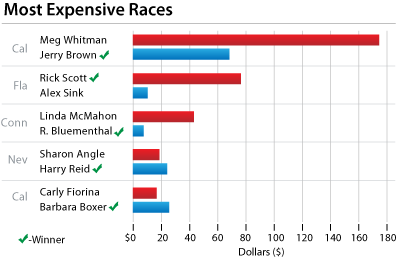This year’s midterm elections shattered previous fundraising records with estimated spending of more than $4 billion. Yet the biggest spenders didn’t necessarily win.
In California, Republican Meg Whitman spent about $175 million — $57 a vote — in her bid to be governor, mostly from her own bank account. (She was once CEO of eBay.) That’s more than any candidate in U.S. history, even adjusted for inflation. She lost to Democrat Jerry Brown, who spent less than half that sum.
Likewise, former World Wrestling Entertainment CEO Linda McMahon poured in more than $41 million of her own money to her U.S. Senate campaign in Connecticut. The Republican lost to Richard Blumenthal, who spent just $6 million. McMahon was one of two Senate candidates who spent $97 per vote – the most spent per vote during the midterm elections — and lost. The other Senate candidate: tea party favorite Sharron Angle, who failed to unseat Democratic incumbent Harry Reid in Nevada.
For some candidates, though, digging into their own deep pockets paid off. Florida Republican Rick Scott, a former health care executive, spent a record $78 million of his own money to become governor in the state’s most expensive election ever.
Congress’s big spenders
Overall, House and Senate campaigns set records, topping $2 billion, an average of about $4 million for each open seat. Several candidates spent significantly more than average: between them, Angle and Reid spent combined $41.5 million.
In the House, the biggest spenders came from Minnesota’s 6th Congressional District: They spent $15 million, more than double the next priciest race. Republican incumbent Michele Bachmann alone spent $11.1 million to hold on to her seat.
Following the money
As predicted, corporations played a bigger role in this year’s elections, thanks to a Supreme Court decision in January that loosened restrictions on corporate and union campaign donations. Political action committees and nonprofits spent about $564 million, contributing to a 73 percent increase in third-party spending compared with 2008.
American Crossroads, a conservative organization co-founded by former George W. Bush aide Karl Rove, spent $50 million on TV ads against Democrats. On the labor side, the American Federation of State, County and Municipal Employees financed one of the biggest third-party pushes late in the election cycle, pitching in a reported $87 million, partly on TV ads to defeat GOP candidates including Nevada’s Angle.
But which corporations are the most generous donors of all time? Mother Jones magazine compiled a list that includes alcohol and tobacco lobbies as well as more unusual supporters, such as the parent company for lingerie emporium Victoria’s Secret.
TV is still king
This may be the Internet era, but when it comes to political campaigns, TV is still king: Two-thirds of ad dollars went to television, Ad Age reported. Though spending for online ads jumped from 2008, it was still a drop in the bucket at less than $45 million.
Ads that received the most media attention were often offbeat, low-budget affairs. Commercials that generated a lot of online buzz featured a showering candidate, a cameo from Chuck Norris, a flock of demon sheep, and a theme song that may have been performed on a Casio keyboard circa 1982 (cue the bossa nova beat).
And most ads had one thing in common: They were negative.
Don’t expect the negative ads to end just because the elections are over. Pennsylvanians are now seeing ads warning about various bills before Congress, thanks to a new “perpetual campaign” strategy. And with the 2012 presidential election just around the corner, expect spending records to topple again.
–Before joining Yahoo! as a Front Page editor, Melissa O’Neil was for 11 years a writer and editor for magazines, including Self, Allure, Glamour, and the now-defunct Cargo and YM.
Other popular Yahoo! stories:
• Bill Gates’ improbable new nemesis



